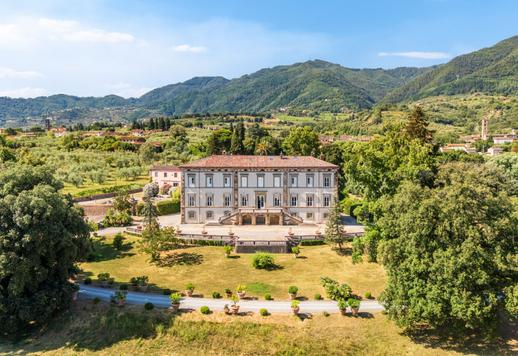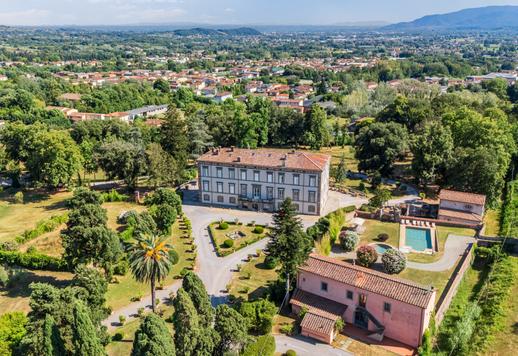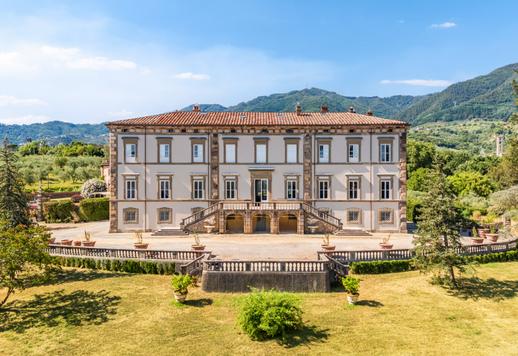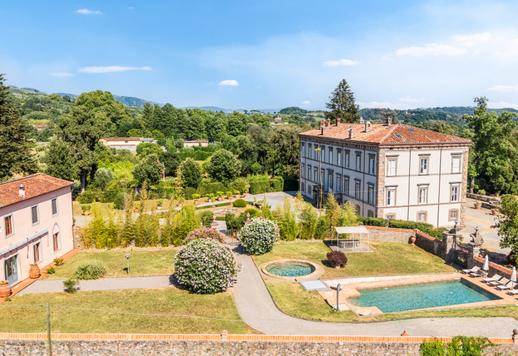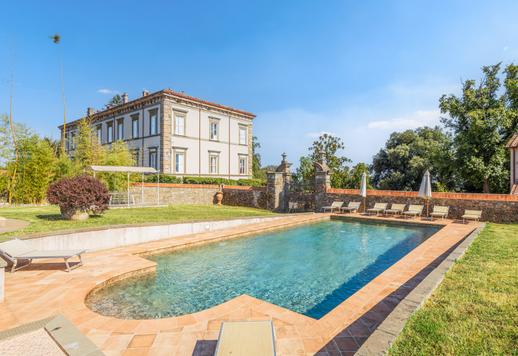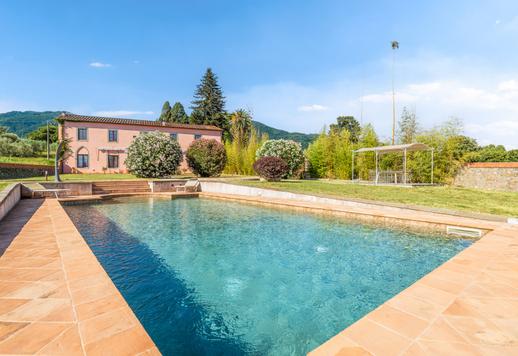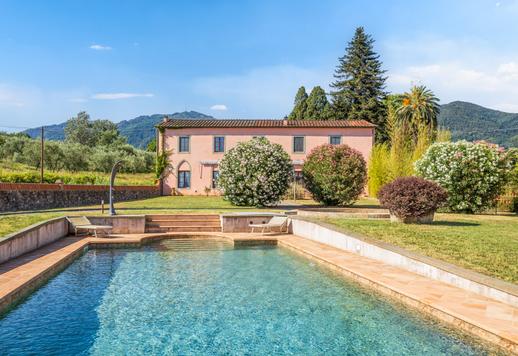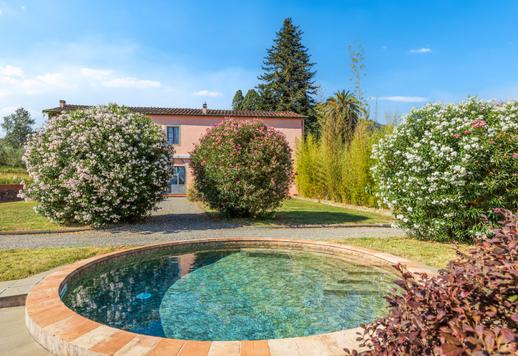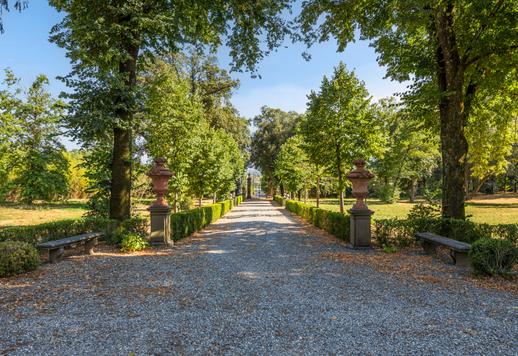
Caroline Bonaparte's Villa On Lucca's Hills
Historical villa for sale in Lucca with two swimming pools, an outbuilding, a centuries-old park and a private church
18th-century estate for sale on Lucca's hills: once home to Caroline Bonaparte, Napoleon's sister and Queen of Naples
In the heart of Lucca's sweet rolling hills, where nature blends harmoniously with art and historical memory, stands this majestic historical villa for sale, one of the most impressive and enchanting country estates in Tuscany. Belonging to Caroline Bonaparte, Napoleon's sister and Queen of Naples, the property covers over 3,200 sqm distributed between the main villa, a refined annexe and a small, perfectly preserved private church. It is surrounded by over 6 hectares of land that include a historic lemon house and ancient wash houses, a monumental park with two swimming pools embellished with box hedges, terracotta statues and ancient gravel paths that still tell the story of the daily life of the great families who once lived here. Every detail – from the decorated halls to the period furnishings, from the great works of art to the skilfully restored original materials – speaks a language that combines beauty and authority, making this residence one of the most precious jewels of the Lucca area.
The villa is located in Lucca's beautiful countryside, just a few minutes from the famous 16th-century walls of Lucca and in a strategic position for easy access to Pisa, Florence and the Versilia coast. The surrounding landscape, which encompasses the plain of Lucca, Lake Bientina and part of the Florentine territory, conveys a sense of peace and grandeur, making this place ideal for those who wish to live immersed in the charm of the most authentic Tuscany.
From an architectural point of view, the villa fully expresses the concept of an 18th-century country home, with a spectacular monumentality that rivals the great urban palaces.
The origins of the building date back to the 16th century, but it was under the guidance of the Lucca merchant Coriolano Orsucci in the 18th century that it was transformed into a truly monumental country residence. Upon his death, his son Carlo and grandson Lorenzo completed the project, as evidenced by the famous inscription still visible today on the lintel of the main floor.
In 1836, the property was purchased by Caroline Bonaparte, wife of Joachim Murat, Queen of Naples until 1815, who retained ownership until her death in 1839. Subsequently, the villa passed into the hands of other aristocratic families linked to Italian history, such as the Tossizza and the Marquises Zanardi Prosperi of Ferrara, who were involved in the uprisings of 1848.
The southern façade, adorned with rusticated pilasters, Guamo stone cornices and a spectacular double staircase, introduces a world suspended in time. During the 18th century, architect Filippo Juvarra created numerous designs and proposals for this property and other noble residences in the area. Although his imposing plans were never fully realised and were gradually simplified, his influence remains evident, particularly in the entrance gate to the walled garden on the west side, a typical rural enclosure in the Lucca tradition that creates a cosy and protected space.
The interior of the villa is spread over three main floors, plus a usable attic and a basement, for a total area of approximately 2,500 sqm. On the ground floor are the old kitchens and service rooms, completely restored to incorporate modern comforts while keeping the original structures intact. Here you can breathe in the authentic atmosphere of everyday life in the villa, among monumental fireplaces, terracotta floors and functional spaces distributed with balance.
The piano nobile is the heart of the villa. The central living room ideally connects the south side, overlooking the park, with the north side, facing the gardens, in a perspective designed to enhance the position of the estate. In the centre is the double-height hall, the largest in the villas of the Lucca area with its 125 sqm and a height of 8 metres, dominated by two monumental paintings attributed to Pier Dandini dated 1710, depicting The Battle of Ponte Milvio and The Abduction of the Sabine Women. It is believed that these works, four metres high and eight metres wide, were brought to the villa by Carolina Bonaparte herself, together with fine period furniture and tapestries, which still enrich the reception rooms today.
The stucco decorations that embellish the hall are attributed to master craftsman Sebastiano Puccini, and extend along the walls and ceilings with scrolls, floral motifs and medallions that represent one of the finest examples of 18th-century decorative art in Lucca. On either side of the hall is a series of decorated rooms, including the famous red chamber, with silk-covered walls and furnishings made by local craftsmen in the first half of the 18th century. The large, symmetrically arranged windows frame views of the garden and the surrounding hilly landscape.
The second floor, currently in need of renovation, is divided into two symmetrical wings with respect to the central hall and houses additional rooms, all overlooking the leafy countryside of Lucca.
Next to the main building, the property includes a refined, finely restored annexe offering five double bedrooms, each with a private bathroom, ideal for guests or for use as hospitality. Although simpler in architectural terms than the main villa, the annexe reflects its elegance in its materials and proportions and guarantees maximum comfort and privacy.
The complex is completed by a small 18th-century private church, intact in its architecture and intimate atmosphere, which adds historical, spiritual and symbolic value to the entire property.
The park surrounding the villa is a space of rare elegance, where tamed nature dialogues harmoniously with architecture and art. The gravel paths wind their way through carefully pruned box hedges, shaped to form green niches, terracotta statues and lush vegetation. The entire landscape is designed to accompany the gaze and the step, in a sensory journey that alternates between shadow and light, order and spontaneity.
Particularly spectacular is the presence of over a hundred potted lemon trees, arranged outside during the summer and kept inside the ancient 18th-century lemon house during the winter months. Completely restored in keeping with the original structure, the lemon house stands out for its large windows and interior space, measuring over 200 sqm, making it perfect for events or exhibitions.
Discreetly set in the landscape are two swimming pools, framed by centuries-old trees and panoramic views of the Lucca hills and Lake Bientina. A third swimming pool, previously located on the south side of the villa, is already authorised and can be easily restored. The outdoor areas also feature an old stone wash house, currently in need of restoration, which could be converted into an additional 50-sqm annex.
A further opportunity is the possibility of purchasing separately the historic 18th-century stables and the old farmer's house, accompanied by an additional 15,000 sqm of land. These buildings, restored in keeping with their original architecture, offer ideal spaces for new residences, wellness areas and charming accommodation facilities, further enriching the exceptional historical and functional value of the complex.
This extraordinary property is much more than a historical villa for sale: it is an artistic legacy, a living document of Italian and European history, and a top-level investment for collectors, lovers of beauty or luxury hospitality entrepreneurs. What makes this place even more precious is its strategic position, just a few minutes from the city of Lucca and close to iconic destinations such as Florence, Pisa and the Versilia coast. Every architectural detail, every glimpse of the park, every memory linked to its famous owners contributes to defining a unique place, destined for those seeking beauty, history, exclusivity and entrepreneurial vision in the heart of Tuscany.
- Garden
- Outbuilding
- Swimming pool
- Private parking space
- Fireplace


